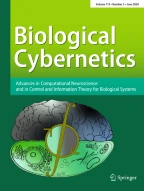Abstract.
In this article the fundamental question of space and time dependencies in the reproduction of spatial or temporal extents is studied. The functional dependence of spatial responses on the temporal context and the corresponding dependence of temporal responses on spatial context are reported as the tau and kappa effects, respectively. A common explanation suggested that the participant imputes motion to discontinuous displays. Using a mathematical model we explore the imputed velocity hypothesis and provide a globally fit model that addresses the question of sequences modelling. Our model accounts for observed data in the tau experiment. The accuracy of the model is improved introducing a new hypothesis based on small velocity variations. On the other hand, results show that the imputed velocity hypothesis fails to reproduce the kappa effect. This result definitively shows that both effects are not symmetric.
Similar content being viewed by others
References
S Abe (1935) ArticleTitleExperimental study on the co-relation between space and time Tohoku Psychol Folia 3 53–68
NH Anderson (1974) Algebric models in perception EC Carterette MP Friedman (Eds) Handbook of perception vol 2 Academic New York
V Benussi (1913) ArticleTitleVersuche zur Analyse taktil erweckter Scheinbewegungen Archiv für die gesamte Psychologie 36 58–135
JC Bill LW Teft (1969) ArticleTitleSpace-time relations: effects of time on perceived visual extend J Exp Psychol 81 196–199 Occurrence Handle1:STN:280:CCaB1MzitlI%3D Occurrence Handle5812173
J Cohen CEM Hansel JD Sylvester (1953) ArticleTitleA new phenomenon in time judgement Nature 172 IssueID4385 901 Occurrence Handle1:STN:280:CyuD3s3hsFc%3D Occurrence Handle13111224
J Cohen CEM Hansel JD Sylvester (1955) ArticleTitleInterdependence in judgments of space, time, and movement Acta Psychol 11 360–372
CE Collyer (1977) ArticleTitleDiscrimination of spatial and temporal intervals defined by three light flashes: effects of spacing on temporal judgments Percep Psychophys 21 357–364
JB Dingwell CD Mah FA Mussa-Ivaldi (2004) ArticleTitleExperimentally confirmed mathematical model for human control of a non-rigid object J Neurophysiol 91 1158–1170 Occurrence Handle14602835
T Flash N Hogan (1985) ArticleTitleThe coordination of arm movements: an experimentally confirmed mathematical model J Neurosci 5 1688–1703 Occurrence Handle1:STN:280:BiqB28zns1I%3D Occurrence Handle4020415
RA Finke RN Shepard (1986) Visual functions of mental imagery KR Boff L Kaufman JP Thomas (Eds) Handbook of perception and human performance, vol.II. cognitive processes and performance Wiley New York
PM Fitts (1954) ArticleTitleThe information capacity of the human motor system in controlling the amplitude of movement J Exp Psy 47 381–391 Occurrence Handle1:STN:280:CyuD1MvosFE%3D
FA Geldard (1972) The human senses EditionNumber2 Wiley New York
JJ Gibson (1966) ArticleTitleThe problem of temporal order in stimulation and perception J Psychol 62 141–149 Occurrence Handle1:STN:280:CCmC2M%2Fnt1E%3D Occurrence Handle5938491
H Helson (1930) ArticleTitleThe tau effect: an example of psychological relativity Sci 71 536–537
H Helson SM King (1931) ArticleTitleThe tau effect: an example of psychological relativity J Exp Psychol 14 202–217
N Hogan (1984) ArticleTitleAn organizing principle for a class of voluntary movements J Neurosci 4 2745–2754 Occurrence Handle1:STN:280:BiqD2MjhtVM%3D Occurrence Handle6502203
B Jones YL Huang (1982) ArticleTitleSpace-time dependencies in psychological judgment of extent and duration: algebric model of the tau and kappa effects Psychol Bull 91 128–142
Kelso JAS (1981) On the oscillatory basis of movement. Bull Psychon Soc 18, 63
EC Lechelt R Bochert (1977) ArticleTitleThe interdependence of time and space in somesthesis: the tau effect re-examined Bull Psychon Soc 10 191–193
D Lee (2000) ArticleTitleLearning of spatial and temporal patterns in sequential hand movements Cogn Brain Res 9 35–39 Occurrence Handle1:STN:280:DC%2BD3c7jt12gsg%3D%3D
M Mashour (1964) Psychophysical relations in the perception of velocity Almquist and Wiksell Stockholm
DE Meyer RA Abrams S Kornblum CE Wright JEK Smith (1988) ArticleTitleOptimality in human motor performance: ideal control of rapid aimed movements Psychol Rev 95 IssueID3 340–370 Occurrence Handle10.1037//0033-295X.95.3.340 Occurrence Handle1:STN:280:BieA3cvjt1I%3D Occurrence Handle3406245
D Mottet RJ Bootsma (1999) ArticleTitleThe dynamics of goal-directed rhythmical aiming Biol Cybern 80 235–245 Occurrence Handle1:STN:280:DyaK1M3lvVSqsg%3D%3D Occurrence Handle10326240
DR Price-Williams (1954) ArticleTitleThe kappa effect Nature 173 363–364 Occurrence Handle1:STN:280:CyuD28vmslI%3D Occurrence Handle13144767
JC Sarrazin MD Giraudo J Pailhous RJ Bootsma (2004) ArticleTitleTau and kappa effects revisited: dynamics of balancing space and time in memory J Exp Psychol Hum Perception Perform 30 IssueID3 411–430
K Schill C Zetzsche (1995) ArticleTitleA model of visual spatio-temporal memory: the icon revisited Psychol Res 57 88–102 Occurrence Handle1:STN:280:ByqB38vitV0%3D Occurrence Handle7708901
S Shigeno (1993) ArticleTitleThe interdependence of pitch and temporal judgments by absolute pitch possessors Percept Psychophys 54 IssueID5 682–692 Occurrence Handle1:STN:280:ByuC3Mbmslc%3D Occurrence Handle8290337
JJ Temprado A Chardenon M Laurent (2001) ArticleTitleInterplay biomechanical and neuromuscular constraints on pattern stability and attentional demands in a bimanual coordination task Neurosci Lett 303 127–131 Occurrence Handle1:CAS:528:DC%2BD3MXislGru7s%3D Occurrence Handle11311509
PCW Wieringen ParticleVan PJ Beek (1997) ArticleTitleDistance versus position information in the control of aiming movements Behav Brain Sci 20 323–324
P Viviani N Stucchi (1992) ArticleTitleBiological movements look uniform: evidence of motor-perceptual interactions J Exp Psychol Hum Percept Perform 18 603–623 Occurrence Handle1:STN:280:By2A28vls10%3D Occurrence Handle1500865
PG Zanone JAS Kelso (1992) ArticleTitleEvolution of behavioral attractors with learning – nonequilibrium phase-transitions J Exp Psychol Hum Percept Perform 18 403–421 Occurrence Handle1:STN:280:By2B2sjgtFI%3D Occurrence Handle1593227
Author information
Authors and Affiliations
Corresponding author
Rights and permissions
About this article
Cite this article
Sarrazin, JC., Tonnelier, A. & Alexandre, F. A model of contextual effect on reproduced extents in recall tasks: the issue of the imputed motion hypothesis. Biol Cybern 92, 303–315 (2005). https://doi.org/10.1007/s00422-005-0553-3
Received:
Accepted:
Published:
Issue Date:
DOI: https://doi.org/10.1007/s00422-005-0553-3



